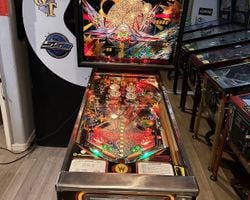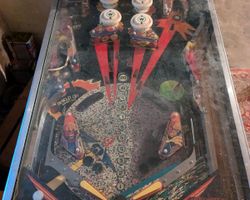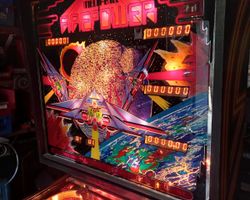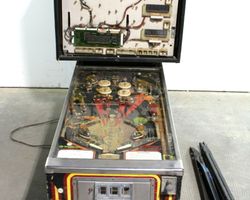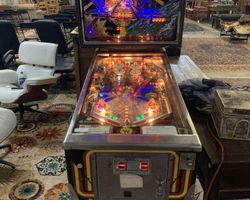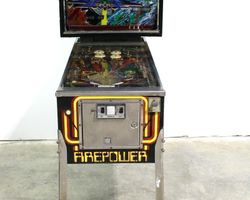Firepower
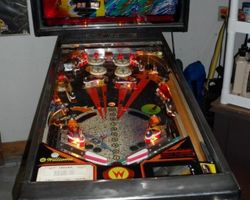
Average Prices: USD $200 to $1,700
Produced: Febuary, 1980
Production Run: 17,410 units
Machine Type: Solid State Electronic
MPU: Williams System 6
Players: 4
Design by: Steve Ritchie
Art by: Constantino Mitchell, Jeanine Mitchell
Mechanics by: John Jung
Sound by: Steve Ritchie, Eugene Jarvis, Randy Pfeiffer
Software by: Eugene Jarvis
Williams Electronics, Incorporated released "Firepower" in February 1980, a solid-state electronic pinball machine that etched its place in the history of the hobby. Designed by Steve Ritchie, with sound and software by Eugene Jarvis, and artwork by Constantino and Jeanine Mitchell, Firepower emerged as a pivotal title, commanding attention with its futuristic, sci-fi, and space war theme. The collaboration between Ritchie's design vision and Jarvis's programming prowess yielded a machine that pushed the boundaries of what pinball could be.
Firepower had a significant production run of 17,410 units, indicating its commercial success and widespread appeal. Its development saw an interesting shift: early prototype versions initially featured two 3-bank drop targets. However, these were ultimately replaced with standup targets for the production model due to reliability concerns, a pragmatic decision that ensured the machine's consistent performance on location. Notably, Steve Ritchie himself provided the distinct voice callouts, adding a layer of personality and direct connection to the game's creator. The game also featured a unique "brick bottom" cabinet design on some units, a result of material sourcing challenges during a period of high demand for pinball machines.
Signature Features and Design
Firepower introduced several groundbreaking innovations that profoundly influenced subsequent pinball machine design. The most prominent was its implementation of electronic multiball, making it the first pinball machine to feature this dynamic gameplay element. Its 3-ball multiball system utilized three distinct physical ball locks, a departure from virtual locks or single entry/exit points, providing a tangible sense of accomplishment as players locked each ball. Furthermore, Firepower’s multiball was "equalized," meaning each player had an equal opportunity to initiate it, regardless of prior locked balls by other players.
Another significant innovation was the "Lane Change" feature, a concept directly born from a collaboration between Steve Ritchie and Eugene Jarvis. This allowed players, for the first time, to use the flipper buttons to shift the lit rollover lanes at the top of the playfield, providing an unprecedented level of player control and strategic depth. Prior to Firepower, such lane changes, if they existed, were controlled by the game's CPU rather than direct player input. The machine also featured animated displays, a visual enhancement that brought new life to the score and game information presentation. The audio experience, crafted by Eugene Jarvis, complemented the fast-paced gameplay with a distinctive, often intense sound design that remains recognizable. The artwork, by Constantino and Jeanine Mitchell, firmly established the sci-fi, outer space war theme with vibrant, detailed imagery that captured the imagination of players.
Playfield and Mechanics
The Firepower playfield is a testament to focused design, emphasizing speed and shot accuracy. At its core, the playfield features two flippers providing control over a layout designed for rapid ball movement. Above the flippers, two slingshots and four pop bumpers contribute to the chaotic energy, propelling the ball unpredictably and increasing scoring opportunities. The primary objective often revolves around hitting the ten standup targets strategically placed throughout the playfield, particularly the central bank of targets that spell out "FIREPOWER" and are crucial for advancing game objectives.
A prominent spinning target adds a dynamic element, rewarding precise shots with high-scoring rotations. The playfield includes three kick-out holes, which collect balls and can be part of the multiball initiation sequence. Two star rollovers contribute to bonus scoring. A notable defensive feature is the left outlane kickback, providing a critical save mechanism that can turn a potential drain into another chance at extending a ball in play. The playfield art is a cohesive extension of the sci-fi theme, depicting spacecraft, explosions, and cosmic landscapes that reinforce the sense of an interstellar conflict. The lighting design works in tandem with the artwork, guiding the player's eye towards key targets and indicating active game features. The layout is engineered to foster a sense of continuous action, rewarding players who can maintain control amidst the swift returns and challenging shot opportunities.
Gameplay Dynamics
Firepower’s gameplay dynamics are characterized by their speed, directness, and addictive nature. The core progression revolves around lighting the "FIREPOWER" targets, spelling out the word, and then advancing through a series of objectives that culminate in the electrifying 3-ball multiball. The strategic use of the lane change feature is integral to maximizing scores, allowing players to manipulate the lit rollover lanes to their advantage for bonus multipliers or extra ball opportunities.
During multiball, the challenge intensifies as players manage three balls simultaneously, aiming to make critical shots and accumulate massive scores. The equalized multiball system ensures that every player has a fair shot at experiencing this high-energy mode. Beyond the primary multiball objective, players also focus on repeatedly hitting the spinner for high-value points and strategically using the kickback to save balls from the left outlane. While some might find the rule set straightforward by contemporary standards, Firepower's true depth lies in its demanding shot accuracy and the relentless flow that pushes players to execute precise shots under pressure. The game demands a high level of skill and ball control, fostering a "just one more game" appeal as players strive to master its fast-paced rhythm and achieve the coveted multiball.
Reception and Legacy
Firepower has garnered a overwhelmingly positive reception from the pinball community, consistently ranking among the most highly regarded solid-state machines of its era. Players frequently praise its fast-paced, challenging, and engaging gameplay, citing its ability to create an addictive experience that encourages repeated plays. The satisfaction derived from hitting the center standup targets and activating multiball is often highlighted as a significant strength.
The machine's innovative features, particularly the introduction of electronic multiball and the groundbreaking lane change, are universally acknowledged as pivotal contributions to pinball design, setting new standards for interactive gameplay. The integrated sound design by Eugene Jarvis, with its distinctive effects and the inclusion of Steve Ritchie's voice callouts, is often cited as contributing significantly to the game's intense and immersive atmosphere. For many, Firepower also evokes a strong sense of nostalgia, representing a quintessential arcade experience from the early 1980s. While the art package is generally well-received for its period, some players express a preference for different artistic styles. A common critique, although minor, points to a tendency for balls to drain down the center or side outlanes, and for some, the gameplay, while challenging, can occasionally feel repetitive due to a focus on a limited set of high-value shots. Despite these minor observations, Firepower’s reputation as a classic and a "must-have" for many collectors remains steadfast. Its innovations influenced a generation of pinball designers, cementing its place as a significant benchmark in pinball history that continues to captivate players with its enduring appeal.
Sponsored Links
 Ebay Listings
Ebay Listings
 Auction Results
Auction Results
| Cost | Location | Date |
|---|---|---|
| USD $2,000 |  United States United States |
22 December, 2025 |
| USD $2,000 |  Wisconsin, United States Wisconsin, United States |
14 November, 2025 |
| USD $3,295 |  Colorado, United States Colorado, United States |
31 July, 2025 |
| EUR €850 |  Schlewig-Holstein, Germany Schlewig-Holstein, Germany |
21 June, 2025 |
| EUR €1,700 |  Bayern, Germany Bayern, Germany |
08 June, 2025 |
| USD $3,000 |  Florida, United States Florida, United States |
13 April, 2025 |
| USD $2,999 |  United States United States |
28 March, 2025 |
| USD $2,400 |  Alabama, United States Alabama, United States |
09 January, 2025 |
| EUR €2,000 |  Schlewig-Holstein, Germany Schlewig-Holstein, Germany |
07 January, 2025 |
| USD $1,800 |  Illinois, United States Illinois, United States |
15 November, 2024 |


Private Policy · Search Website · Contact Us
As an eBay Partner, we may earn a commission from qualifying purchases made through links on this site, at no additional cost to you.
All trademarks and copyrighted materials remain property of their respective owners. All other content copyright 2007 - 2026 Pinpedia.

